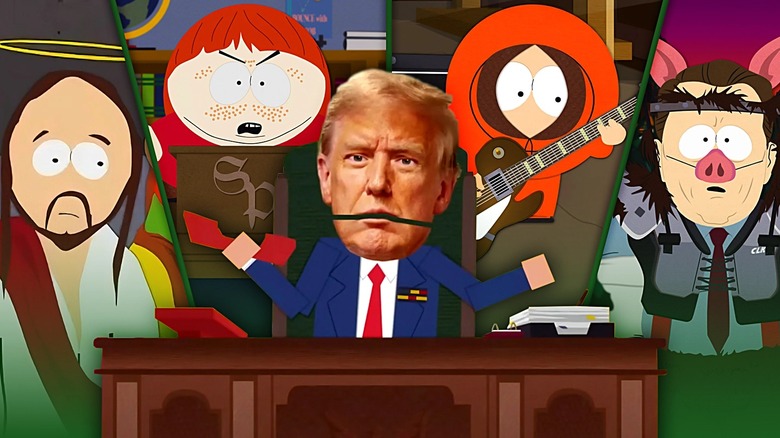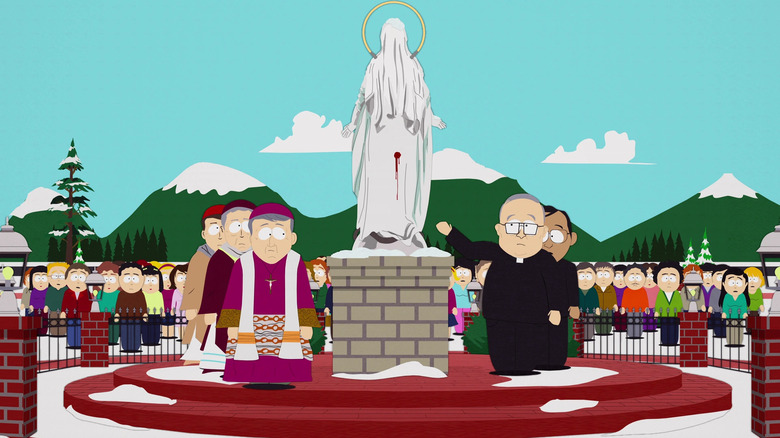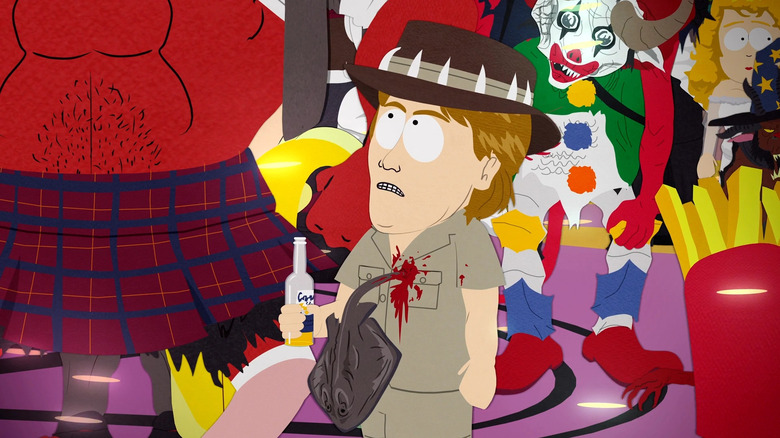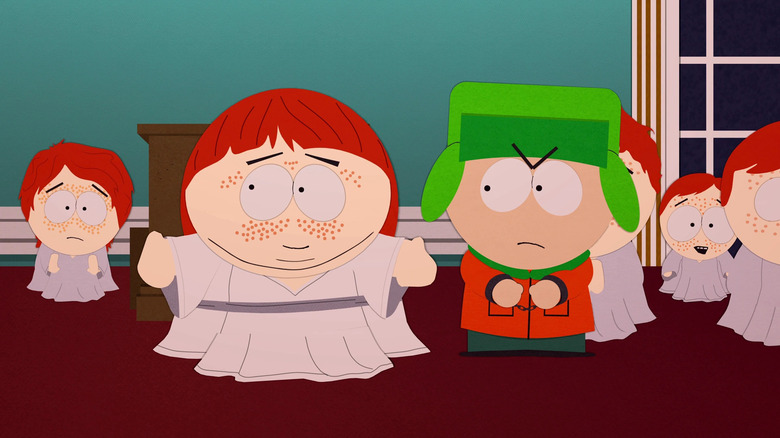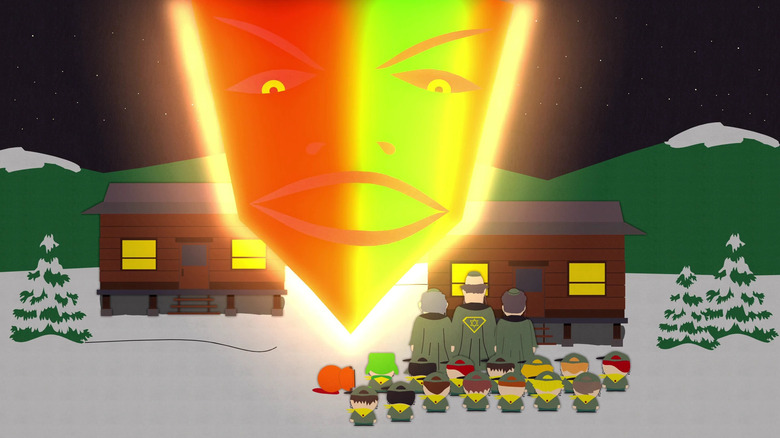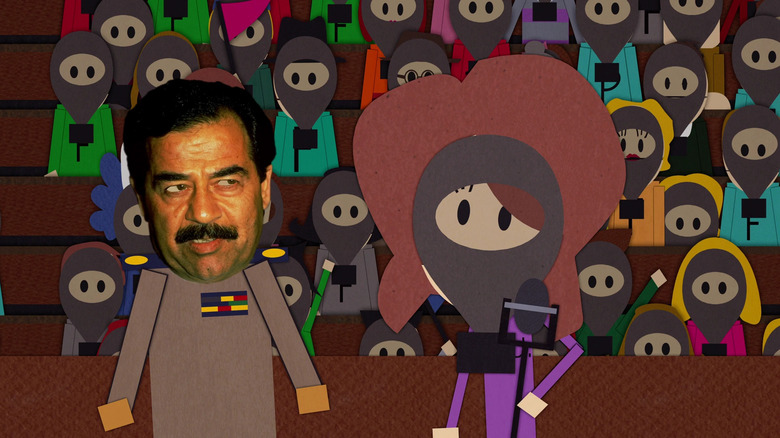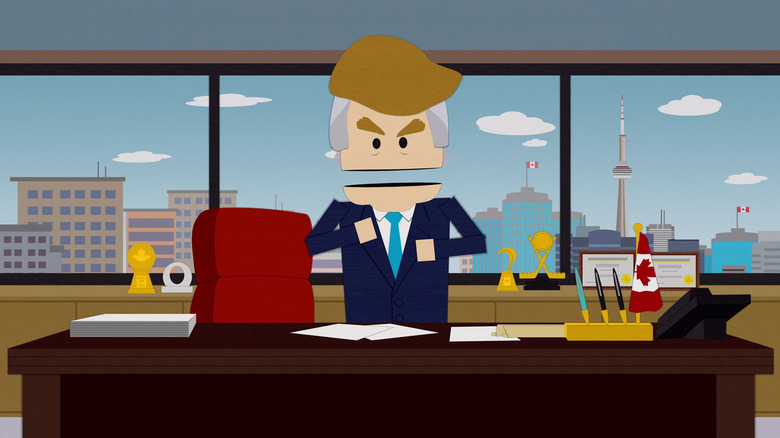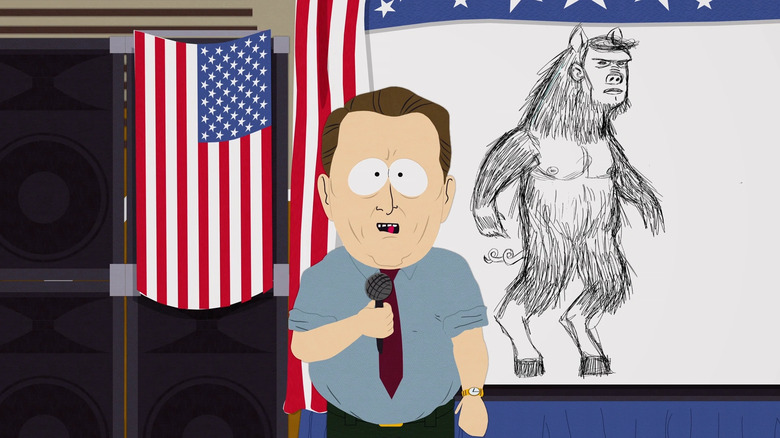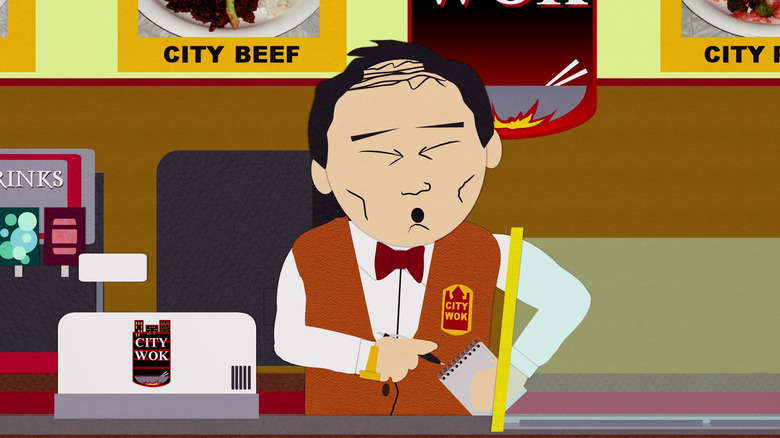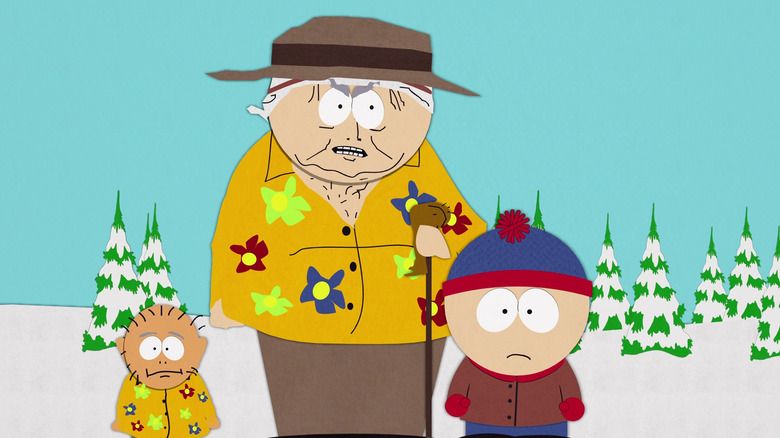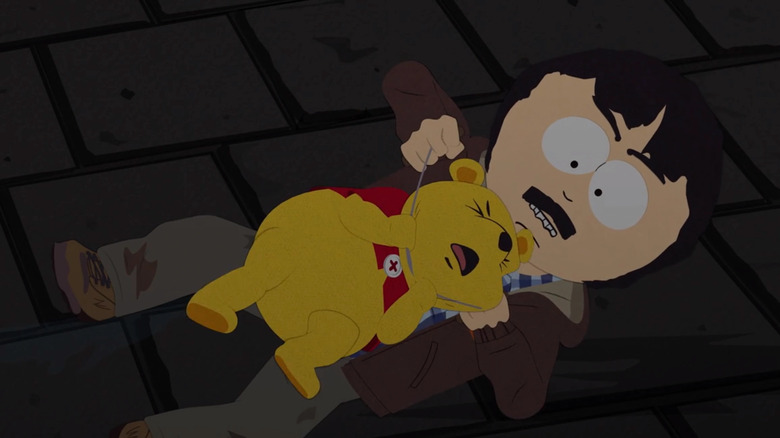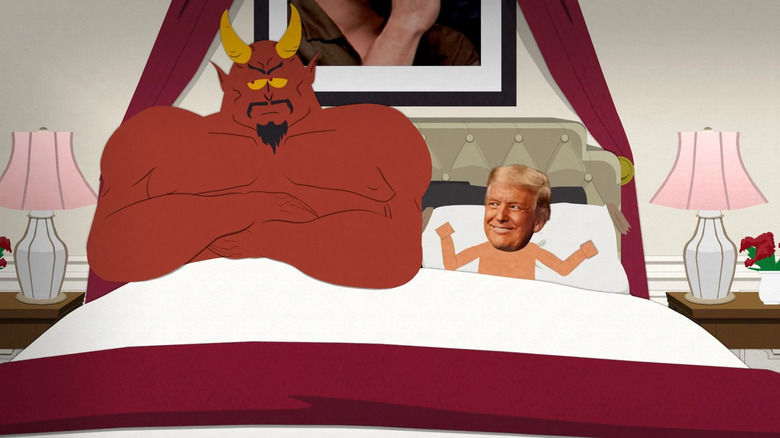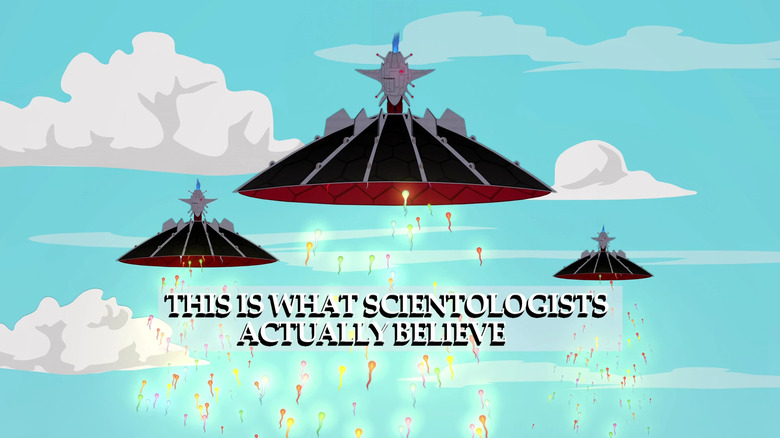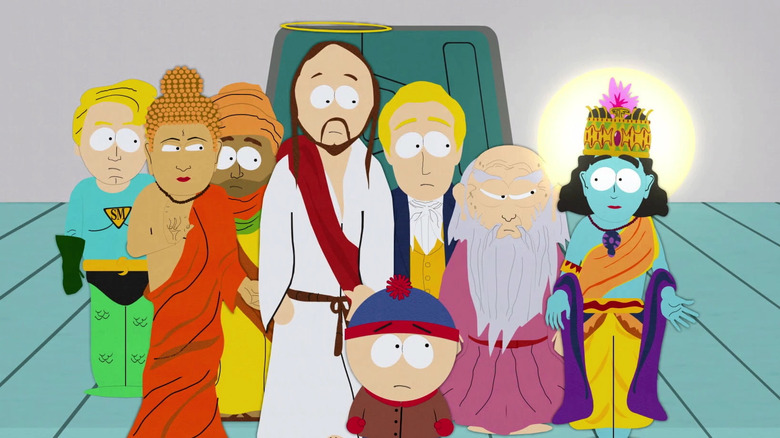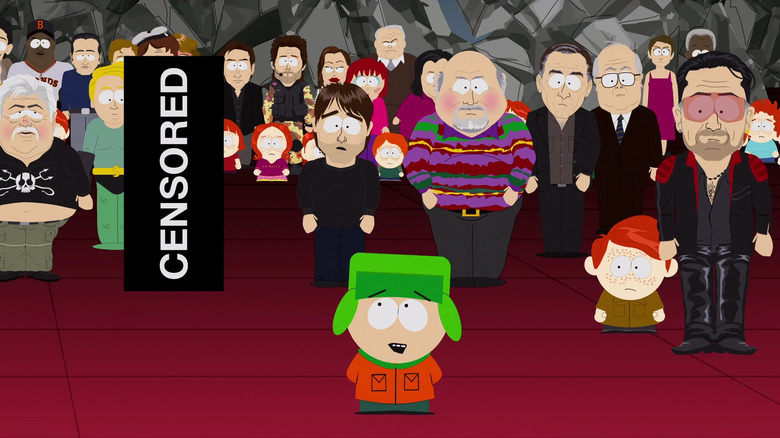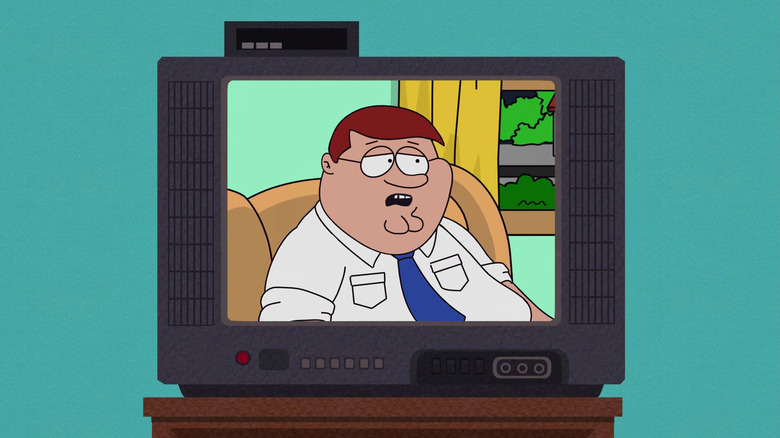The 15 Most Controversial South Park Episodes Of All Time
Incest. Abortion. Pedophilia. Transphobia. Ableism. Blasphemy. These are many of the theoretically taboo topics that Trey Parker and Matt Stone's transgressive "South Park" has featured in episodes over the years. Liberals think the show is for them when it goes after bigotry and corporate corruption; conservatives think it's for them when it attacks environmentalists and anti-smoking celebrities. Yet sometimes the most offensive episodes aren't necessarily the ones that cause the biggest controversies — the Mormon Church, for example, has remained relatively calm at all the mockery thrown their way by the show — and sometimes the topics one might expect to be hot-button get overshadowed by other details in the same episode.
As such, listing the most offensive episodes might take forever. Below, we have instead listed 15 "South Park" episodes that generated verifiable external controversies, for both serious and frivolous reasons. Let's take a closer look at them.
15. Bloody Mary
In a satire of the 12-step program, Randy Marsh gets sent to Alcoholics Anonymous, but takes the step of admitting powerlessness over one's addiction the wrong way, and starts to drink more. Believing only a miracle can cure him, he makes a pilgrimage to a statue of the Virgin Mary that has reportedly been bleeding out of her rear end. Randy believes himself cured, but when Pope Benedict XVI declares the statue is not miraculous because it's only bleeding from the vagina, and all women do that, Randy is forced to admit he might have some control over his drinking after all.
Religious leaders were not amused; in the U.S., the Catholic League demanded that the episode be pulled, with at least one Catholic member of Viacom's board agreeing. Similar groups complained in Australia and New Zealand. While the episode did not immediately appear in reruns, it has since gone back into rotation.
14. Hell on Earth 2006
This was one of the few episodes to actually get more graphic after its first airing, as a gag featuring Jeffrey Dahmer, Ted Bundy, and John Wayne Gacy as the Three Stooges restored initially censored bits of gore. That wasn't the problem, though.
The plot centers on Satan throwing a Halloween party in the style of the reality show "My Super Sweet 16." Numerous denizens of Hell are invited. Satan initially chastises a guest for being too soon to wear a costume based on Crocodile Hunter Steve Irwin, with the stingray that killed him still attached, then realizes it's the real Irwin, and kicks him out for not wearing a costume. Irwin had died the previous month, and his widow, Terri, put out a statement that she was devastated and concerned their kids would see it.
Parker and Stone were caught by surprise, but noted that they depict most celebrities as going to Hell anyway.
13. Ginger Kids
After Eric Cartman publicly expresses his belief that freckled, redheaded kids ("Gingers") are literally soulless vampires, Stan Marsh, Kyle Broflovski, and Kenny McCormick sneak into his bedroom overnight and give him a makeover so that he'll believe he has become a Ginger himself. Briefly picked on as a result, Cartman immediately pivots to declaring Gingers the master race and advocating that they should kill everyone else. Only when Kyle reveals the truth about the prank does Cartman pivot again, this time to a philosophy of peaceful co-existence, which he admits is just to save his own skin.
Though the entire point of the story is the hypocrisy of prejudice, the episode is blamed for instigating anti-redhead bullying, including an informal event called "National Kick a Ginger Day," which began as a Facebook group and extended internationally into the U.K. and Ireland. Later on, musician Ed Sheeran would semi-jokingly blame the episode for ruining his life.
12. Jewbilee
The title sounds inflammatory, and indeed, the episode "Jewbilee" was banned in Romania and Hungary. As "South Park" episodes go, though, it's not one that would normally be singled out for anti-Semitism. In other episodes, Cartman has dressed as Adolf Hitler and even tried to behave like him. "Jewbilee" merely sends Kyle, his younger brother Ike, and tag-along Kenny on a camping trip with Jewish scouts. There, they engage in typical arts and crafts, though they must also reckon with members of an anti-Semitic synagogue that worships the 5th-century Persian official Haman. Ultimately, the kids summon Moses, and he resembles the Master Control Program from Disney's groundbreaking, CG-enhanced movie "Tron."
"South Park" sometimes inelegantly straddles the line between mocking bigotry and simply indulging it, but "Jewbilee" pretty clearly celebrates Jewish kids enjoying camp, and mocks stereotypes about supposed Jewish self-loathing. It's tough to claim that depicting Moses as a sentient computer program from a Disney movie relies on any kind of hateful trope.
11. Terrance and Phillip in Not Without My Anus
"South Park" ended its first season on a cliffhanger: Who is Eric Cartman's father? The break wouldn't last all summer long — "Cartman's Mom Is a Dirty Slut" ended with the announcement that viewers would have to wait four weeks. What many didn't pay attention to was that the season 2 premiere would be on April Fools' Day, and the joke would be on anybody hoping for an immediate resolution. Instead, everyone was treated to a full-length episode featuring Terrance and Phillip, the farting comedy duo from Canada whose fictional show is beloved by the boys, taking on Saddam Hussein.
Over 2,000 angry viewers contacted Comedy Central to complain, prompting Matt Stone to comment that there was something wrong with people getting that angry about "a little construction paper kid's father." (We called it one of the five worst "South Park" episodes) Three weeks later, Comedy Central aired the actual follow-up episode, revealing Cartman's mother, Liane, to be intergendered and really his father.
10. Where My Country Gone?
"South Park" tried to warn us about Donald Trump's candidacy in September 2015. In "Where My Country Gone?" Canada has become a post-apocalyptic wasteland due to its new president, a joke candidate who kept getting attention because people thought his over-the-top antics and outrageous claims were funny. The president is never named, but he certainly has a familiar general appearance.
In the rest of the episode, we saw the beginnings of Mr. Garrison becoming the show's Donald Trump surrogate, as he demands that America build a wall to keep Canadian immigrants out. Upon learning that Canada has already built one to keep Americans out, Garrison sneaks in and discovers that the Canadian Trumpy guy is the one driving Canadians into the United States. To end the problem once and for all, Garrison sexually assaults him to death. That accomplished, he pledges to run for president himself in 2016.
Even left-leaning papers like The Guardian ran with tsk-tsk headlines like "South Park depicts Donald Trump being brutally murdered." The Daily Mail, meanwhile, called it "an almost unprecedented attack on a running presidential candidate." The episode itself sort of came true: As TV shows laughed at candidate Trump, he laughed all the way to the White House.
9. ManBearPig
A mockery of the Al Gore-starring documentary "An Inconvenient Truth," about global anthropogenic climate change, "ManBearPig" sees the former vice president arriving in South Park to find and defeat an imaginary monster named ManBearPig. He's convinced it's a real threat, but his actions to preemptively defeat it wind up endangering the boys, and by the end of the episode, there's no evidence whatsoever that the creature exists. The implication is that he's a metaphor for global warming, and that Gore is an egomaniacal alarmist.
Except...maybe not. As Parker and Stone came to accept that maybe the climate threat Gore warned us about was real and accurate after all, they gave us the episode "Time to Get Cereal," 12 years later, in which everyone begins to acknowledge that ManBearPig is real, and killing people, but there's nothing anybody can do about it, so why care? Gore comes to the rescue, and we learn that the creature is the result of a deal made with the devil by Stan's grandpa Marvin ... a subtle way of blaming the older generation for not dealing with the problem.
8. Jared Has Aides
"Jared Has Aides" centered on Subway commercial pitchman Jared Fogle, who would be arrested as a sex offender a dozen years later. Jared's TV commercials boasted about his weight loss from eating a diet of Subway sandwiches; in the "South Park" episode, he seemingly announces he actually lost the weight because he got AIDS. It's a misunderstanding — he means to say he had aides who helped him — but the show pushes the joke as far as it can go. In hindsight, his line about giving children AIDS/aides hasn't aged well.
That, however, isn't the controversial part. In an attempt to make money like Jared, the boys try to cut a deal with the local Chinese fast-food establishment City Wok, wherein they'll make Butters lose weight while eating nothing but Chinese food. The proprietor, later named Tuong Lu Kim, is a broadly racist caricature who speaks in broken "Engrish" and constantly pronounces the word "City" as "Sh**ty." Like a lot of racial stereotypes on "South Park," the show seems to be lampooning the silliness of the stereotype as much as it is using it, but ultimately, even Parker and Stone seemed to realize Lu Kim went too far. They retconned him into an alternate personality of a white man who thought himself to be Asian.
7. An Elephant Makes Love to a Pig
Even as far back as season 1, "South Park" was causing controversy. The fifth-ever episode, which aired in September 1997, was a parody of the 1996 movie "The Island of Dr. Moreau." Kyle, wanting a pet elephant that isn't too large to keep at home, turns to Dr. Mephesto, a character who resembles Marlon Brando's Moreau, in the hopes that he can crossbreed an elephant with a pot-bellied pig. Instead, he creates a mad, giant-sized clone of Stan. Meanwhile, the real Stan has a problem in that his sister Shelley keeps beating him up.
Originally, there was a scene where Shelley kept setting Stan on fire, then dousing him with water so as not to kill him, then setting him on fire again. Mindful of the controversy "Beavis and Butt-head" faced over similar material, Comedy Central deleted it after the initial airing. On the DVDs, a pool of water under Stan is still visible; on the Blu-ray, it has vanished completely. Trey Parker and Matt Stone have claimed not to remember the details, and Comedy Central has not mentioned it again.
6. Band in China
Numerous shows and movies make compromises in order to get past Chinese censors and make money. By attacking that very practice, "South Park" had to know it was destroying that market for itself, and indeed, "Band in China" got the entire series, well, banned in China.
Randy looks to expand his legal marijuana business into China, blissfully unaware that it's illegal there, and that he didn't invent the idea of expanding business into China. Meanwhile, Stan's band signs a recording deal, but since the only money in the music business now is in biopics, they'll need to make one of those ... just as soon as they remove anything that might be offensive to the communist Chinese government. Stan maintains his integrity and ultimately refuses; Randy doesn't, and murders Winnie the Pooh (to whom Chinese leader Xi Jinping is often unflatteringly compared), getting himself in the Chinese government's good graces.
The actual Chinese government was not amused.
5. Sermon on the Mount
"South Park" has been around since Bill Clinton was president, and has mocked him and every successor since. Only one has thrown a fit about it on social media, and that's the current White House occupant.
For most of Donald Trump's first term in office, "South Park" only mocked him vicariously by having Mr. Garrison become president while behaving similarly to the real thing. Trey Parker and Matt Stone cited the fact that everyone else was mocking Trump as reason enough to focus elsewhere. During the second term, with the Trump administration demanding payouts from universities and allegedly only approving a Paramount-Skydance merger after they canceled the late-night show of Trump critic Stephen Colbert, "South Park" unloaded with both barrels with its season 27 premiere.
"Sermon on the 'Mount" picks a fight with Trump by comparing him to the late Iraqi dictator Saddam Hussein, portraying him similarly to how Hussein was written in the "South Park" movie, right down to him being Satan's gay lover. The episode also gives him a small penis and has him suing everyone, up to and including Jesus Christ. The show concludes with a "pro-Trump" PSA that the town of South Park has been forced to make, using AI to show a photo-real, obese Trump look-alike.
4. Trapped in the Closet
The Church of Scientology had established a reputation as a litigious organization that would sue any of its critics for religious discrimination. By counting Tom Cruise and John Travolta among its acolytes, it also cultivated an aura of being industry-connected. This made the group a tempting target for "South Park," especially after Parker and Stone heard that Penn Jillette had been banned by Showtime for criticizing the church.
In the episode, Stan is identified by Scientology as the reincarnation of its founder, L. Ron Hubbard. He learns the actual secret origin of the universe, involving the galactic warlord Xenu, as told only to top-ranking members, while an on-screen title reads, "This is what Scientologists actually believe." When Stan later tries to make these secret scriptures free, the president of Scientology reveals to him that the organization is a money-making scam. In a side plot, Cruise gets offended by a perceived snub and hides in a closet, where he is joined by John Travolta, riffing on rumors that both actors are secretly gay.
Scientologist Isaac Hayes, who played the long-running character Chef, reportedly quit the show thereafter. However, his son and others have since clarified that amid Hayes' escalating health issues, the church had quit on his behalf.
3. Super Best Friends
"Super Best Friends" comes from a more naive, innocent time — July 4, 2001. Sure, we all knew militant Islamic terrorism was a general global threat, but had mostly compartmentalized it. That would end two months later.
At the time, though, the main target of the episode was "street magician" David Blaine, and more obliquely, the Church of Scientology, as the Blaine character on the show forms a cult called Blaintology. To stop him, the South Park kids summon Jesus, who assembles the Super Best Friends, based on the "Super Friends" cartoon but featuring religious icons in place of superheroes ... mostly. In addition to Jesus, Buddha, Joseph Smith, Krishna, Lao Tse, and Muhammad, the group includes Sea Man, a parody of Aquaman and his perceived uselessness before Jason Momoa made him cool again.
Nobody seems to have told Trey Parker and Matt Stone at the time that Muslims consider any visual depiction of Muhammad, even a positive one, to be a grave insult. There didn't seem to be any major protests at the time. In the years since, however, the episode has been retroactively censored, and if you didn't already know why, keep reading ...
2. 200/201
This landmark two-part episode of "South Park" was meant to be an epic callback to multiple fan-favorite storylines. Many of the plotlines that have made this list thus far were included, among them the Ginger kids and various celebrities' sensitivity to criticism. Where it ran into trouble was its callback to the episode listed below.
Riffing on Comedy Central's censorship of any image of Muhammad, even in cartoon form, the anniversary episode had Tom Cruise seeking to be as immune to parody as Muhammad by stealing his essence. Muhammad is cautiously used as a character, kept either off-camera or implicitly in a costume, with others in-universe wondering out loud if that still counts as acceptable. Cruise thinks he has stolen Muhammad's essence, but when Stan unintentionally mocks him by saying Sea Man is on his back (thus creating a homonymic gay innuendo), Kyle realizes there is no essence goo that can be stolen, and gives a speech about how the only way to guarantee a lack of mockery is through threats and intimidation.
Comedy Central censored that speech, apparently fearful that it would be read as blanketly accusing all Muslims offended by Muhammad imagery of being prone to violence. The episodes haven't been aired again, and even the Blu-ray versions keep the speech censored.
1. Cartoon Wars (Part I and II)
In September 2005, the Danish newspaper Jyllands-Posten published 12 editorial cartoons of Muhammad. In theory, it was an experiment to see if professional cartoonists legitimately felt threatened for doing so. In practice, as many might expect, it was considered a grave blasphemy, sparking protests around the world, some of which turned violent and deadly.
As cartoonists themselves, Parker and Stone find it irresistible to do anything they're told they can't do, and as a side benefit, take shots at Seth MacFarlane's "Family Guy," a series they hate hearing "South Park" compared to simply because both are edgy adult animation shows. So in "Cartoon Wars," which aired in April 2006, the premise is that "Family Guy" is going to air an image of Muhammad, which Fox plans to censor. Rather than standing up for the free speech that they claim to support, most of the residents of "South Park" literally bury their heads in the sand.
Cartman and Kyle initially team up to get Fox to pull the episode until Kyle discovers that Cartman doesn't actually care about Muslims — he just hates "Family Guy." Kyle relents, his free-speech argument sways Fox, and the episode airs — only for Comedy Central itself to censor the "South Park" depiction of the "Family Guy" Muhammad scene, for real. This set a precedent that would ultimately result in five episodes being banned from subsequent airings, including these two.
